 loading
loading
featuresThe man who saved the dinosaursDinosaurs were lumbering, stupid, scientifically boring beasts—until John Ostrom rewrote the book on them. Richard Conniff ’73 is the author, most recently, of The Species Seekers: Heroes, Fools, and the Mad Pursuit of Life on Earth. 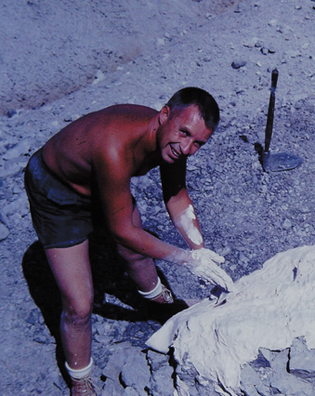 Courtesy of Karen OstromYale paleontologist John Ostrom, shown here in 1962 plastering a Camptosaur for shipping, changed the way the world thinks about dinosaurs. View full imageIn the summer of 1970, early in the research that would radically transform how we think about birds, dinosaurs, and the origins of animal flight, Yale paleontologist John H. Ostrom was traveling through Europe studying pterosaur fossils. His itinerary took him, in early September, to the Teylers Museum in Haarlem, the Netherlands. Ostrom, then 42, was an unprepossessing figure and the world’s leading authority on dinosaurs, and the museum curator was pleased to leave him alone with the twin halves of the limestone slab catalogued TM6928 and 29. This fossil was a dinner plate–size muddle of limb fragments, vertebrae, and ribs preserved in limestone from the Solnhofen beds. It had been discovered near Riedenburg, Germany, in 1855 and named by the great nineteenth-century paleontologist Hermann von Meyer. Von Meyer later became famous for the first scientific description, in 1861, of Archaeopteryx. Coming just after the publication of Charles Darwin’s On the Origin of Species, the unveiling of that 150-million-year-old urvogel, or archetypal primitive bird, made an international sensation. With Archaeopteryx, it seemed as if the proof of evolutionary theory had arrived, like the Ten Commandments, engraved in stone. But in 1857, the confusing fossil von Meyer was describing—the future TM6928 and 29—seemed like something far more ordinary: another pterosaur, a type of flying reptile. He dubbed it Pterodactylus crassipes. That didn’t make sense to Ostrom as he puzzled over the ankles, toes, and arm bones of the fossil that day in 1970. He could envision the ways they might fit together just by examining the proportions of the bones and the shape of their articulations. But it wasn’t like any pterosaur he had ever seen. Ostrom had recently finished describing a remarkable dinosaur he had discovered a few years earlier in Montana. His monograph on Deinonychus included exquisitely detailed descriptions showing how the bone endings and attachments helped make these dinosaurs such fast, agile little killers. To Ostrom, the bones of the Teylers specimen looked an awful lot like those of Deinonychus. And there was something more. 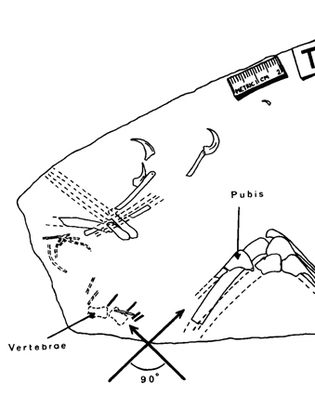 John Ostrom/Yale UniversityA sketch of the Teylers Museum specimen that Ostrom included in a 1976 paper, “Archaeopteryx and the Origin of Birds.” View full image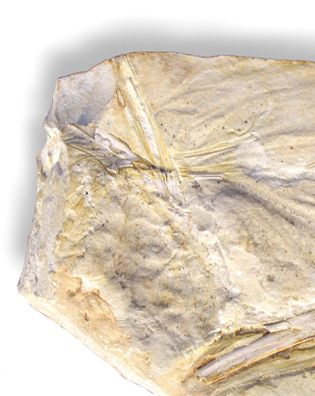 Courtesy Teylers MuseumOne of the two halves of the Teylers Museum specimen that eventually led Ostrom to conclude that birds evolved from dinosaurs. View full imageOstrom picked up one of the slabs, carried it over to the window, and held it up at an angle in the light. First one way, then the other. The late afternoon sun caught on some faint ridges. Ostrom was seeing, unmistakably, the clear impression of feathers. This fossil wasn’t Pterodactylus after all. It was another Archaeopteryx. In fact, it would have been the scientific world’s first Archaeopteryx, if von Meyer had gotten his taxonomy right. In 1970, only three other specimens of Archaeopteryx were known to exist. But this was by no means the only thing that excited Ostrom at that moment. His mind was already ticking over about the resemblance to Deinonychus—and the unsettling idea that the wrist and shoulder bones of a primitive bird should be identical to those of a small meat-eating dinosaur. To write a proper technical description, Ostrom needed to take the specimen home to the Peabody Museum at Yale for closer study. A crisis of conscience ensued: should he mislead the Teylers curator, telling him it was merely a pterosaur, only to make the great discovery back home? Or should he come out with the truth and risk that the museum would lock up these suddenly precious slabs of rock? Being a “squeaking honest” man, in the words of a former student, Ostrom confessed his belief that it was Archaeopteryx. The curator immediately took back TM6928 and 29 and hurried out of the room. Ostrom slumped in his seat, despairing. A few minutes later, the curator returned with a shoebox tied up with string. He handed it to Ostrom, with the specimen inside, and, beaming, declared, “You have made our museum famous.” It was the beginning of something far bigger than either man could have guessed. 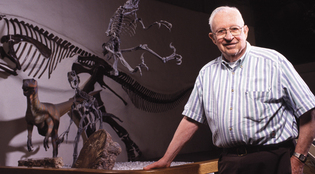 Courtesy Yale Peabody Museum of Natural HistoryFor 30 years, Ostrom steadily and meticulously refuted critics of his theories. He is shown here in the Yale Peabody Museum, near a Deinonychus in mid-leap. View full imageIn the public imagination then, dinosaurs were plodding, thunderous monsters, cold-blooded and stupid. Even paleontologists had lost interest in these “symbols of obsolescence and hulking inefficiency,” Ostrom’s student Robert T. Bakker ’67 later wrote. “They did not appear to merit much serious study because they did not seem to go anywhere: no modern vertebrate groups were descended from them.” But dinosaurs had begun to look a lot more interesting one afternoon in late August, 1964, near Bridger, Montana. Ostrom and his assistant Grant E. Meyer had been walking a landscape of prairie punctuated with rocky, eroding outcrops, considering sites for the following summer’s fieldwork, when they spotted a large, clawed dinosaur hand protruding from the earth on a slope just below them. They scrambled down, dropped to their knees beside it, and because they hadn’t brought their toolkit, began digging excitedly with their hands, and then with their jackknives, turning up a scattering of the serrated teeth of a predator. Next day, returning with proper tools, they unearthed an astonishing foot. Two of three toes had ordinary claws. But from the innermost toe, a sharp sickle-shaped claw curved murderously up and out. It had a slashing arc, Ostrom later calculated, of 180 degrees. Hence the eventual name Deinonychus, or “terrible claw.” Ostrom and his crew spent two full field seasons digging at the site and three years in study and reconstruction at the Peabody, working with more than a thousand bones from at least four individuals of the same species. Then in 1969, Ostrom announced what he called a “grandiose” conclusion: that foot was “perhaps the most revealing bit of anatomical evidence” in decades about how dinosaurs really behaved. In place of the plodding, cold-blooded dinosaur stereotype, Deinonychus “must have been a fleet-footed, highly predaceous, extremely agile, and very active animal, sensitive to many stimuli and quick in its responses,” Ostrom wrote. The “dinosaur renaissance,” as Robert Bakker later dubbed it, had begun. 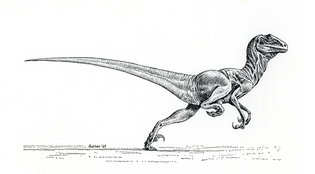 Robert BakkerDeinonychus in full sprint, as drawn by Robert Bakker ’67—a student of Ostrom’s and a crusader for the view that dinosaurs were active, dynamic animals. The drawing appeared in Ostrom’s 1969 paper announcing the discovery of Deinonychus. View full imageBakker had been a student member of the 1964 Montana expedition, and he contributed a drawing to Ostrom’s paper showing a fleshed-out Deinonychus in full sprint. The “terrible claw” on the hind legs was lifted up and out of the way of its feet, keeping it sharp. That drawing would soon become the icon of the new dinosaur. Bakker had latched onto many of Ostrom’s ideas as an undergraduate and, to Ostrom’s occasional chagrin, he ran with them. Bakker—“the infamous Bob Bakker,” as Peter Dodson ’74PhD, another former Ostrom student, says—became the outspoken advocate of dinosaurs as active, warm-blooded, and even “superior” animals. “Where John was cautious, Bob was evangelical,” Dodson and Philip Gingerich ’74PhD later wrote. “Each deserves considerable credit for revolutionizing our concept of dinosaurs.” In his book The Riddle of the Dinosaur, science writer John Noble Wilford added that Bakker “was the young Turk whose views could be dismissed by established paleontologists. Ostrom, however, could not be ignored.” Late in 1969, Ostrom took the challenge directly to the North American Paleontological Convention in Chicago, declaring in a speech that there was “impressive, if not compelling” evidence “that many different kinds of ancient reptiles were characterized by mammalian or avian levels of metabolism.” Traditionalists in the audience responded, Bakker later recalled, with “shrieks of horror.” Their dusty museum pieces were threatening to come to life as real animals. Ostrom went on, over the next half dozen years, to draw out the similarities between Deinonychus and Archaeopteryx specimens, including the Teylers fossil. Among the titles in a series of landmark papers he published: “The Ancestry of Birds,” “The Origin of Birds,” and “Archaeopteryx and the Origin of Flight.” The idea that birds had evolved from dinosaurs was not entirely new, as Ostrom pointed out. T. H. Huxley, “Darwin’s Bulldog,” had argued, for instance, that a link between the reptile-like bird Archaeopteryx and the bird-like reptile Compsognathus would close an evolutionary gap. But subsequent scientific opinion had shifted to the counter-argument—that the many similarities between birds and dinosaurs were merely instances of convergent or parallel evolution. Paleontologist Gerhard Heilmann’s 1926 book The Origin of Birds killed off the dinosaur connection seemingly forever. His argument came down to wishbones: Birds had what is properly known as a furcula. Dinosaurs didn’t even seem to have the collarbones, or clavicles, that fuse to form the furcula. Ostrom pointed out that this was “negative evidence only and thus inconclusive.” A lot of biological features are missing from the fossil record, he noted, and that doesn’t make them any less real. Collarbones in particular are delicate and might easily not have survived, or not in any recognizable form. In any case, several dinosaurs with clavicles had already turned up before Heilmann published his book. Many more have come to light since then. Against this false negative, Ostrom laid out the positive evidence, listing more than 20 anatomical similarities between Archaeopteryx and various dinosaurs. It wasn’t just that Ostrom could not be ignored. He was far too thorough and meticulous, and for 30 years too persistent in the face of his critics, for anyone to refute. Though one or two holdouts still resist the idea, it is now widely accepted that birds evolved from the group of bipedal theropod dinosaurs that includes Deinonychus, Tyrannosaurus, Velociraptor, and other familiar species. They are now all grouped together as Maniraptora, or “hand-snatchers,” a taxonomic classification named in 1986 by Jacques Gauthier (now a Peabody curator). The idea that birds are in fact living dinosaurs is so commonplace that the debate has largely turned to the question of why they were the only dinosaurs to survive the mass extinction of 65 million years ago. Ostrom gave up fieldwork in the 1970s because of a physical ailment. But he had always believed that “the best discoveries are made in museum storerooms,” and his own correct identification of TM6928 and 29 had been “a classic example of why a paleontologist or museum should not throw things away that can’t be absolutely classified as worthless.” Holed up in his paper-stacked office at the Peabody, studying fossils with his magnifying spectacles, he continued to publish important articles on dinosaurs, birds, and the evolution of avian flight. As Ostrom quietly continued his work, the dinosaur renaissance spread out from that office to become a “dinosaurian flooding of popular consciousness,” as the paleontologist Stephen Jay Gould later put it—with countless books, endless computer-generated dinosaurs on television, and multiple iterations of Jurassic Park, the last of these directly inspired by Ostrom and Deinonychus. The dinosaur renaissance also caused a debate that persists even now, among bemused paleontologists and parents alike, about why so many of our children are caught up in the raging, teeth-baring grip of full-on dinomania. (The short answer: John Ostrom.) More significantly, Ostrom lived to see his ideas about the dinosaur origin of birds—and the feathered plumage of dinosaurs—vindicated by a series of remarkable fossils from northeastern China. These discoveries began in 1996, with Sinosauropteryx (“Chinese lizard wing”), a small theropod dinosaur with a mantle of short, dark, feather-like filaments on its back. (“I literally got weak in the knees when I first saw photos,” Ostrom told a reporter.) And it culminated in 2012 with the 3,100-pound Yutyrannus, a T. rex relative, only bigger, fiercer, and covered in tufts of long, filamentous feathers. Canadian researchers browsing through a museum collection of amber even found actual dinosaur feathers and downy “dino fuzz.” The Jurassic Park movie franchise (with the fourth installment now in production) continues to hold out for scaly, reptilian dinosaurs, to the chagrin of better-informed children in the audience. But scientific and popular renderings of many dinosaur species now look as ornately feathered as faux Indians at Mardi Gras. On Ostrom’s death in 2005, age 77, the Los Angeles Times wrote that he had “almost single-handedly convinced the scientific community that birds are descended from dinosaurs.” “John Ostrom,” the Sunday Times (London) added, “did more than anyone else to make dinosaurs interesting, real, and visceral.” When NPR’s All Things Considered marked the occasion by interviewing Ostrom’s first research student, Bob Bakker, the paleontological world held its breath for a moment, recalling the troubled relationship between these two allies in the dinosaur renaissance. But when asked how important Ostrom had been to dinosaur paleontology, Bakker graciously commented: “Nobody was more important.” Eight years before his death, Ostrom himself had already published what was his own best epitaph, in the view of the Peabody’s Daniel Brinkman ’94MPhil. In “a last word” to a paper called “How Bird Flight Might Have Come About,” Ostrom wrote: “The missing, unknowable fossil record can never be allowed to stifle our curiosity.” There is one more piece of this story that’s never been told in print: heading back to his hotel with the Teylers specimen that day in 1970, having discovered the first new Archaeopteryx in 24 years, Ostrom had to stop at a public restroom. Afterward, he continued on his route, perhaps caught up in contemplating the struggle and the triumphs ahead. Suddenly, to his horror, he realized that he was empty-handed. He had left the shoebox containing not just the fossil, but also his destiny, the fame of the Teylers Museum, the course of paleontology for decades to come, and the not-yet-imagined dinosaur dreams of untold armies of dinosaur enthusiasts, perched, abandoned, on a wash basin in a public restroom. Ostrom frantically retraced his footsteps—and found the shoebox untouched. He snatched it up and clutched it to his breast all the way back to the hotel, and to New Haven. And thus John H. Ostrom saved the future for dinosaurs.
|
|
7 comments
-

Jim Kirkland, 11:22am July 12 2014 |  Flag as inappropriate
Flag as inappropriate
-

Paul Sereno, 4:09am July 17 2014 |  Flag as inappropriate
Flag as inappropriate
-

Charles Kjelland, 9:39am July 26 2014 |  Flag as inappropriate
Flag as inappropriate
-

Michael L. Lazare, 3:22pm September 09 2014 |  Flag as inappropriate
Flag as inappropriate
-

Katy Bongo, 5:46pm March 26 2015 |  Flag as inappropriate
Flag as inappropriate
-

Jennifer Nicole Wattry, 5:50pm March 26 2015 |  Flag as inappropriate
Flag as inappropriate
-

James L. Knight, 8:49pm April 15 2017 |  Flag as inappropriate
Flag as inappropriate
The comment period has expired.John Ostrom was always very kind to me as a young paleontologist. His old professor Edwin H. Colbert had been my mentor (well into his retirement in Flagstaff, Arizona). When I first started making by discoveries in the Lower Cretaceous of Utah (25 years ago), John sent me stacks of literature to get me on the right track of what would become my life's work.
Naming the giant dromaeosaur ("raptor"), Utahraptor ostrommaysorum was just a small bit of my admiration for this great man. In 1990, at the annual meeting of the Society of Vertebrate Paleontology (SVP) in San Diego, when I showed the Bakker the killing claw of Utahraptor; he just blew it off as a crushed Torvosaurus claw, but minutes later, John was swinging it around displaying its size in life and what kind of damage it would have been able to do. He attracted a good crowd in a very Bakkeresk manner (he would hate hearing that).
Finally, the literal high point of my career was at the 1996 SVP meeting at the American Museum of Natural History, where I co-moderated the dinosaur session, so as a young scientist I was already on a cloud. However, my greatest memory was standing alone in the hall talking with John about my research, when Phil Currie walked up to us with Prof. Yen and showed John the first feathered dinosaur found in China. Remembering,the tears welling up in Prof. Ostrom's eyes always brings tears to me own. Certainly, witnessing John's conformation of his prediction that feathered dinosaurs probably existed was my personal professional high point. This moment, I treasure more than all my dinosaur discoveries, as for the first time I felt as if I was truly a part of paleontology's history. Thank you John!
John Ostrom's seminal contributions were many, but central to his life story is the link between dinosaurs and birds, or more properly, placing the bird radiation within the dinosaur radiation as a specialized branch of theropods. To do this he not only was in the right place at the right time---and here I am speaking about his discovery of more complete materials of one of Barnum Brown's Cloverly wonders, the unveiling in many ways for the first time of a very birdlike theropod, which he named Deinonychus. He did more than simply point out the great number of similarities between this theropod and the early bird Archaeopteryx. He argued that these similarities were derived. That is, that they were synapomorphies---shared morphology from common ancestry.
Although not a practitioner himself of cladistic methods that were in the 1980s and 1990s transforming what we now know about dinosaur descent, he was sympathetic. His work was translated in this light by the mid 1980's by colleague and now his successor as Yale Professor, Jacques Gauthier. The story misses this important development, that long before finding the first feathered dinosaur in the mid 1990s, the vast majority of paleontologists and an increasing number of young ornithologists realized and had accepted the mountain of osteological evidence, which Ostrom had pioneered, that frames birds as dinosaur descendants. Feathered dinosaurs were icing, yes emotional icing, on the cake. And it was a marvelous thing that he lived to bear witness.
Dr. Ostrom started his career at Beloit College as an assistant professor, teaching a variety of courses such as geomorphology, invertebrate paleontology, and sedimentation. I had the privilege of taking those courses in 1957 and 58. Of course, he then went on to Yale and great fame, but he certainly shaped geology careers very early!
Articles such has this keep YAM near the top of my list of indispensable general-interest magazines.
Wow that was brave I wouldn't even dare trying that hey wasn't it dangerous?? Ohhkkk eshh brave hey
Can anyone try bringing dinosaurs back to earth?
I first met John in his second or third year of prospecting in the Cloverly Formation, which happened to be on my uncle's TX Ranch. I was to spend my 16th summer working on the ranch and my uncle told me on the way from the train station that a Yale crew was digging up dinosaurs. I insisted that we stop and see what was going on. I spent the next five days watching over John's shoulder as his field crew took Tenontosaurus tilletti (which John named after my uncle's brother), and other taxa, out of the ground. I'll never forget that...!
Years later, after John and I had renewed our friendship, he was nearing retirement and I was headed back to the TX. John and I were talking on the phone about the ranch and he said, "Jim, you're killing me! I am a real TX officionado!" So I suggested that John fly into Billings, Montana, the closest airport, and I would pick him up for an "old times sake" trip back to the TX and the Cloverly, to which he immediately agreed. I called Jack Horner, who came down to the TX with his wife, Celeste, and the bunch of us had a wonderful return to the ranch. When we hiked out to the site where John had showed me dinosaurs in the ground so many years ago, he went out and sat on a little hill (the one from which many of the photos for his Cloverly monograph were taken), and just sat there. When he rejoined the rest of us he had tear stains on his cheeks.
John was a guest at my home in Aiken, SC, several times over the years after that TX trip, and invariably we talked about what a great time we had there.